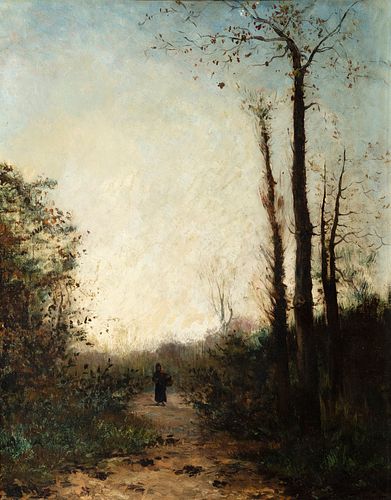MODEST URGELL INGLADA (Barcelona, 1839 - 1919). "Landscape with figure". Oil on canvas.
Lot 27
About Seller
Setdart Auction House
Carrer Aragó 346
Barcelona
Spain
Setdart Subastas was born in 2004 and is currently the first online art auction in Spain with solidity, prestige and reliability guaranteed by our more than 60,000 users. Setdart has a young, dynamic and enterprising team ready to successfully manage the purchase and sale of art works through custom...Read more
Estimate:
EUR€1,800 - EUR€2,000
$1,894.74 - $2,105.26
Absentee vs Live bid
Two ways to bid:
- Leave a max absentee bid and the platform will bid on your behalf up to your maximum bid during the live auction.
- Bid live during the auction and your bids will be submitted real-time to the auctioneer.
Bid Increments
| Price | Bid Increment |
|---|---|
| EUR€0 | EUR€10 |
| EUR€200 | EUR€25 |
| EUR€500 | EUR€50 |
| EUR€1,000 | EUR€100 |
| EUR€3,000 | EUR€200 |
| EUR€5,000 | EUR€500 |
| EUR€10,000 | EUR€1,000 |
| EUR€20,000 | EUR€2,000 |
| EUR€50,000 | EUR€5,000 |
About Auction
By Setdart Auction House
Oct 27, 2021
Set Reminder
2021-10-27 10:00:00
2021-10-27 10:00:00
America/New_York
Bidsquare
Bidsquare : 19th & 20th Century Paintings & Decorative Arts
https://www.bidsquare.com/auctions/setdart-auction-house/19th-20th-century-paintings-decorative-arts-7767
Setdart Auction House sofia@setdart.com
Setdart Auction House sofia@setdart.com
- Lot Description
MODEST URGELL INGLADA (Barcelona, 1839 - 1919). "Landscape with figure". Oil on canvas. Signed in the lower left corner. Measurements: 58.5 x 46 cm; 83 x 71 cm (frame). Modest Urgell began his career as a theatrical actor, but the family prohibition to follow that path led him to devote himself to painting. He studied at the Escuela de La Lonja in Barcelona, where he was a disciple of Ramón Martí Alsina, and later spent some time in Paris, where he met Gustave Courbet and became attached to realism. During the sixties, his works were rejected in the official exhibitions of Madrid and Barcelona. In 1870 he moved to Olot, where he became acquainted with Joaquín Vayreda, creator of the local landscape school. From then on, Urgell decided to devote himself fully to landscape painting. His work will focus on solitary natures and seascapes, often starring hermitages and cemeteries, marked by a twilight, desolate and mysterious atmosphere. From 1896 he taught landscape painting at the School of Fine Arts of Sant Jordi in Barcelona, being appointed academician in 1902. He was also founder of the Artistic and Literary Society of Catalonia, as well as of the Artistic and Archaeological Museum of Girona. He took part in all the editions of the National Exhibition of Fine Arts, in Madrid, from 1864 until a year before his death, and was awarded the second medal in 1876 and 1892. He also sent his paintings to the exhibitions of Barcelona, as well as to the Universal Exhibition of Paris and the International Exhibitions of Munich, Brussels, Berlin, Philadelphia and Chicago. In 1892 he was awarded in all the contests in which he participated, among them the one in Brussels, in which he was the only Spanish winner. He also devoted himself to literature, with a special interest in theater. The sum of his two passions, art and literature, are expressed in his album "Catalunya" (1905), made up of more than one hundred drawings accompanied by texts written by himself. His landscapes have an atmosphere, a color and themes that deny the stereotype of the Mediterranean landscape, based on warm and friendly natures, of brilliant chromatism, like windows open to the southern sensuality. His paintings, on the contrary, speak of melancholy and loneliness, and time and again recreate a desolate and sad Catalonia to which, years later, the poet Salvador Espriu would also be sensitive. His language rejects any fanciful or picturesque theme, picking up current issues without trying to ennoble or idealize them, but seeking to provoke moods in the viewer through twilight lights that dissolve, for brief moments, in harmony of reds, or his desolate cemeteries and severe seascapes, naked and stripped. Urgell is represented in the Prado Museum, the National Art Museum of Catalonia, the Maritime Museum of Barcelona, the Kunsthalle of Hamburg, the Víctor Balaguer Museum of Vilanova i la Geltrú, the Art Funds of the Caixa Sabadell and the Caixa d'Estalvis de Terrassa, the Dalí Museum in Figueras and the Provincial Museums of Gerona, Palma de Mallorca and Lugo, among many other centers and institutions.
- Shipping Info
-
In-house shipping available. Please inquire at admin@setdart.com.
-
- Buyer's Premium



 EUR
EUR CAD
CAD AUD
AUD GBP
GBP MXN
MXN HKD
HKD CNY
CNY MYR
MYR SEK
SEK SGD
SGD CHF
CHF THB
THB














